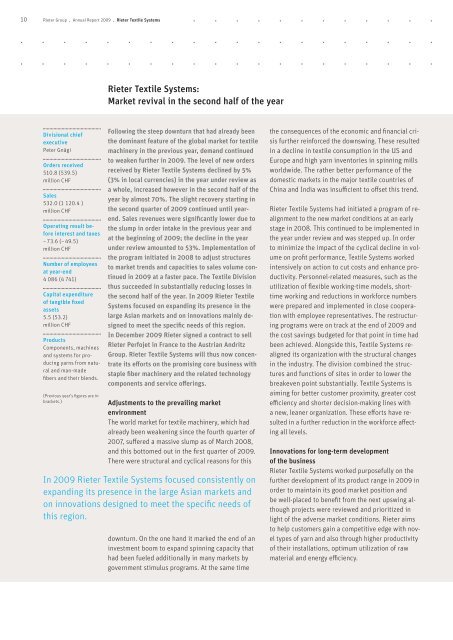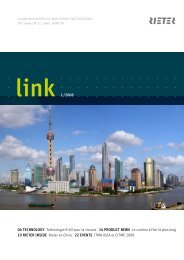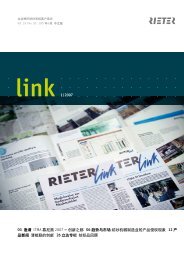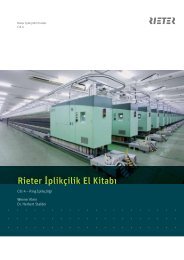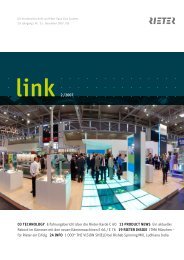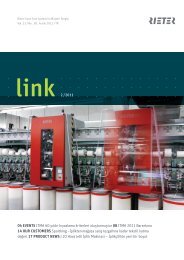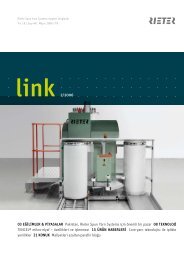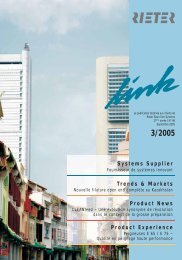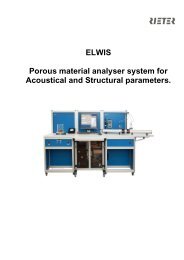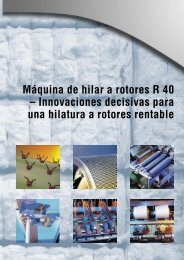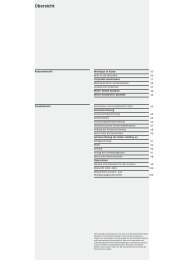Annual Report 2009 - Rieter
Annual Report 2009 - Rieter
Annual Report 2009 - Rieter
You also want an ePaper? Increase the reach of your titles
YUMPU automatically turns print PDFs into web optimized ePapers that Google loves.
10 <strong>Rieter</strong>-Konzern <strong>Rieter</strong> Group . <strong>Annual</strong> . Geschäftsbericht <strong>Report</strong> <strong>2009</strong> <strong>2009</strong> . <strong>Rieter</strong> . Abschnitt Textile Systems<br />
Divisional chief<br />
executive<br />
Peter Gnägi<br />
Orders received<br />
510.8 (539.5)<br />
million CHF<br />
Sales<br />
532.0 (1 120.4 )<br />
million CHF<br />
Operating result before<br />
interest and taxes<br />
– 73.6 (– 49.5)<br />
million CHF<br />
Number of employees<br />
at year-end<br />
4 086 (4 741)<br />
Capital expenditure<br />
of tangible fixed<br />
assets<br />
5.5 (53.2)<br />
million CHF<br />
Products<br />
Components, machines<br />
and systems for producing<br />
yarns from natural<br />
and man-made<br />
fibers and their blends.<br />
(Previous year’s figures are in<br />
brackets.)<br />
<strong>Rieter</strong> Textile Systems:<br />
Market revival in the second half of the year<br />
Following the steep downturn that had already been<br />
the dominant feature of the global market for textile<br />
machinery in the previous year, demand continued<br />
to weaken further in <strong>2009</strong>. The level of new orders<br />
received by <strong>Rieter</strong> Textile Systems declined by 5%<br />
(3% in local currencies) in the year under review as<br />
a whole, increased however in the second half of the<br />
year by almost 70%. The slight recovery starting in<br />
the second quarter of <strong>2009</strong> continued until yearend.<br />
Sales revenues were significantly lower due to<br />
the slump in order intake in the previous year and<br />
at the beginning of <strong>2009</strong>; the decline in the year<br />
under review amounted to 53%. Implementation of<br />
the program initiated in 2008 to adjust structures<br />
to market trends and capacities to sales volume continued<br />
in <strong>2009</strong> at a faster pace. The Textile Division<br />
thus succeeded in substantially reducing losses in<br />
the second half of the year. In <strong>2009</strong> <strong>Rieter</strong> Textile<br />
Systems focused on expanding its presence in the<br />
large Asian markets and on innovations mainly designed<br />
to meet the specific needs of this region.<br />
In December <strong>2009</strong> <strong>Rieter</strong> signed a contract to sell<br />
<strong>Rieter</strong> Perfojet in France to the Austrian Andritz<br />
Group. <strong>Rieter</strong> Textile Systems will thus now concentrate<br />
its efforts on the promising core business with<br />
staple fiber machinery and the related technology<br />
components and service offerings.<br />
Adjustments to the prevailing market<br />
environment<br />
The world market for textile machinery, which had<br />
already been weakening since the fourth quarter of<br />
2007, suffered a massive slump as of March 2008,<br />
and this bottomed out in the first quarter of <strong>2009</strong>.<br />
There were structural and cyclical reasons for this<br />
In <strong>2009</strong> <strong>Rieter</strong> Textile Systems focused consistently on<br />
expanding its presence in the large Asian markets and<br />
on innovations designed to meet the specific needs of<br />
this region.<br />
downturn. On the one hand it marked the end of an<br />
investment boom to expand spinning capacity that<br />
had been fueled additionally in many markets by<br />
government stimulus programs. At the same time<br />
the consequences of the economic and financial crisis<br />
further reinforced the downswing. These resulted<br />
in a decline in textile consumption in the US and<br />
Europe and high yarn inventories in spinning mills<br />
worldwide. The rather better performance of the<br />
domestic markets in the major textile countries of<br />
China and India was insufficient to offset this trend.<br />
<strong>Rieter</strong> Textile Systems had initiated a program of realignment<br />
to the new market conditions at an early<br />
stage in 2008. This continued to be implemented in<br />
the year under review and was stepped up. In order<br />
to minimize the impact of the cyclical decline in volume<br />
on profit performance, Textile Systems worked<br />
intensively on action to cut costs and enhance productivity.<br />
Personnel-related measures, such as the<br />
utilization of flexible working-time models, shorttime<br />
working and reductions in workforce numbers<br />
were prepared and implemented in close cooperation<br />
with employee representatives. The restructuring<br />
programs were on track at the end of <strong>2009</strong> and<br />
the cost savings budgeted for that point in time had<br />
been achieved. Alongside this, Textile Systems realigned<br />
its organization with the structural changes<br />
in the industry. The division combined the structures<br />
and functions of sites in order to lower the<br />
breakeven point substantially. Textile Systems is<br />
aiming for better customer proximity, greater cost<br />
efficiency and shorter decision-making lines with<br />
a new, leaner organization. These efforts have resulted<br />
in a further reduction in the workforce affecting<br />
all levels.<br />
Innovations for long-term development<br />
of the business<br />
<strong>Rieter</strong> Textile Systems worked purposefully on the<br />
further development of its product range in <strong>2009</strong> in<br />
order to maintain its good market position and<br />
be well-placed to benefit from the next upswing although<br />
projects were reviewed and prioritized in<br />
light of the adverse market conditions. <strong>Rieter</strong> aims<br />
to help customers gain a competitive edge with novel<br />
types of yarn and also through higher productivity<br />
of their installations, optimum utilization of raw<br />
material and energy efficiency.


